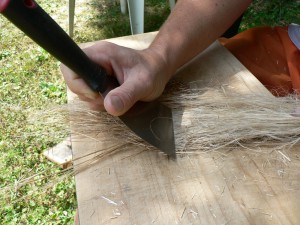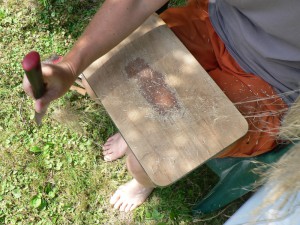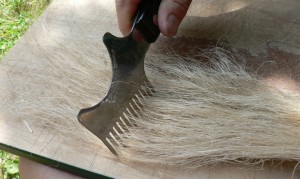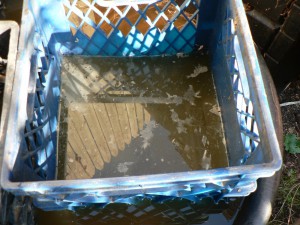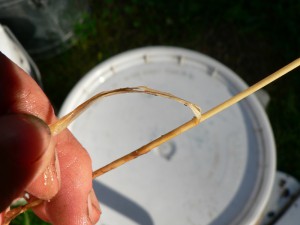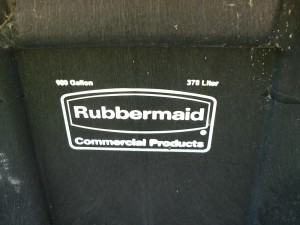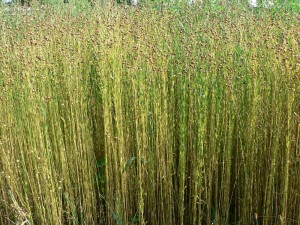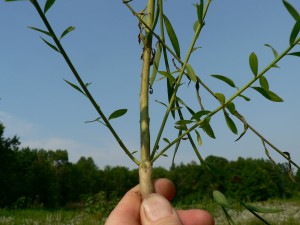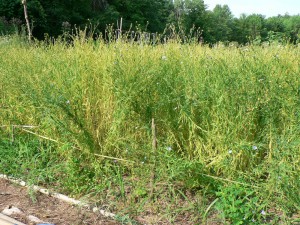Rippling is the process of removing seed pods from dried flax straw before retting. Traditionally, the dried bundles of flax were pulled through a comb-like tool called a ripple to remove the pods. You can see pictures of ripples here. Flax seeds are a very useful commodity, and can be pressed for oil, fed to animals or people, or saved to plant the following year. Continue reading “To Ripple or Not to Ripple”
Dressing Flax
At long last, I have been processing some of my stash of retted and broken flax. This process is traditionally called dressing, though I am not using traditional tools or techniques. However, I am having success using a variation on a method that Chris Hammel (12/24/2023 link updated) showed me, which utilizes tools from the kitchen and hardware store, and other tools that a fiber person might have lying around the apartment.
Many of these bundles I believe were under-retted, which makes it hard to clean them. On the other hand, it’s not impossible, and I am feeling relieved not to have ruined several years’ worth of fiber.
First, I “scutch” with a flexible 3 inch putty knife on an old wooden cutting board.
All the small branches at the top break right off at this point. I’m not sure how useful they might be for other projects because they are still attached to the woody parts of the plant and I think they would be really hard to clean. I scrape them onto the ground. Some I put into the compost, and some I save in a bag for the time being. The photo below shows a clump of tow falling to the ground.
I actually split my bundles into two or three sections for dressing. The size I originally tied when I harvested, which seemed fine for drying and retting, is too thick to handle all at once. I start at the branchy end of the mini-bundle first, then work down toward the middle. Then I flip it over, start at the root end, and work toward the middle. The middle is the hardest part to clean because the fibers are denser here. I spread it out into as thin a layer as I can and scrape and scrape. This part takes a long time.
Next, I use a spiky comb-like tool that I bought at Leader Hardware here in Amherst (12/24/2023 Now Ace/Hamshaw). I don’t know what its real function is supposed to be, but it works very well as my “rough hetchel.” Chris says she uses a metal dog comb, which is probably similar. I like the fact that mine is spiky. I don’t know if the spikes really help or not, but I still like it.
Last Year’s Flax is Retted
Summer is rushing along, tipping noticeably toward fall. The Concord grapes are ripe and fragrant, waiting, camouflaged, to surprise passers by. “Mmm, what’s that smell? Oh, grapes!” But right behind our apartment it currently smells like a retting tank and a woad vat. It’s not “Mmm,” it’s somewhere between “Uh…?” and “Ugh!”
Here in Amherst I am happy to report that we have been having glorious weather for the past week. Flax retting, a modest amount of flax processing, dyeing, making salsa (not really in the scope of this blog, I know) are all continuing apace.
For several weeks, the majority of this year’s flax has been drying on the hay tedder in the tractor shed over at Amethyst Farm (thanks to the generosity of the Brennans). To make room to move this year’s crop gradually into the back of our car (which serves as our shed) I had to ret last year’s flax. I posted about that earlier. That is now all complete.
I retted the first batch (from our community garden) in the 50 gallon tank. I didn’t change the water at all during the retting period (from July 27th to August 2nd–six days). Here’s how the water looked when it was ready to pull out.
Note the yellowish grey film on top.
At the flax demonstration in Gilmanton, NH, Gina Gerhard had given Faith and me a tip on how to check when your retting is complete: the fiber should pull away from the stem with absolutely no resistance.
Michelle’s Excellent Flax Adventure
On Saturday July 28th I took a long drive up to Gilmanton, NH to meet flax dresser Gina Gerhard, and to see a newly excavated historical flax retting pond. Fellow flax aficionado Faith made the long journey, too. Even though it is too late for you to see Gina in Gilmanton, it is not too late for you to enjoy Faith’s absolutely outstanding interactive program about flax at the History Workshop at Historic Deerfield. (12/24/2023 Edited to add that the link to Faith’s flax program no longer works so I deleted it.)
I am not a very ambitious driver, but despite the long haul it was well worth the trip. I met a lot of other flax enthusiasts, including fellow Master Weaver Diane Howe demonstrating her flax spinning skills and beautiful antique wheel. I came back very excited and motivated to persevere with my flax endeavors. This process is so fraught with trial and error, in my case mostly error, that it takes a lot of encouragement to persist. I am very grateful to all the folks in the flax and linen study group I’m part of for constant advice and support. Continue reading “Michelle’s Excellent Flax Adventure”
New Flax Retting Tank
I bought a giant stock watering tank today! I was tempted by the 300 gallon tank they had at Amherst Farmers Supply, but I settled for this one.
In case you can’t read the blurry number, it’s 100 gallons! It is twice the volume of my current tank. I am very excited. Obviously it’s not for watering animals, it’s for retting flax. Continue reading “New Flax Retting Tank”
Retting Last Year’s Flax
Last year, 2011, I grew flax in two locations: our community garden plot and Bramble Hill Farm. The plot at Bramble Hill was about 4 feet by 15 feet. I planted on May 1st and harvested on August 1st (nice and festive). At the community garden I put in two beds 3 by 30 feet, but I got it in really late: May 29th. Also, we had the plot rototilled, rather than digging it over by hand as I usually do. Perhaps for both these reasons, it got really overrun with weeds, primarily grass. I wasn’t very pleased with the quality of the flax fiber-wise, so I decided to try saving it for seed. I let it stand much longer than I normally would have, and didn’t harvest until October 6th, which was 122 days after planting. I found to my dismay, however, that most of the seeds were immature. Later I finally learned that the flowers require pollination by insects, including bees, to be fertilized. I also found that the dry seed heads shatter easily, and a lot of the seed had fallen onto the ground before I harvested. And, thanks to close observation this summer, I can now assert with confidence that small creatures were probably eating the seeds. Continue reading “Retting Last Year’s Flax”
Flax Harvest at Amethyst Farm
Back on July 16th I pulled the flax at Amethyst Farm. It was the last plot I harvested, and ideally I should have pulled it about a week earlier, judging by how many stalks were totally brown and dry by the time I got around to it. We had some extremely hot weather that put those poor plants right over the edge. But you do what you can do.
Here’s the Evelin seen from the south side of the plot.
Marilyn at Amethyst Brook
Well, I thought I was done writing about the flax harvest at Amethyst Brook, our community garden plot, but I forgot to write about the Marilyn. Partly this is due to the fact that my camera started to die around this time, and I didn’t get a lot of photos. The Marilyn, as you may recall, had been the first variety to suffer from lodging. If you don’t recall, because you’re very reasonably not obsessed with all my flax triumphs and woes, I’ll recap. Continue reading “Marilyn at Amethyst Brook”
More Flax Harvesting at Amethyst Brook
In the last post I forgot to show these images of a particularly robust v.n.s. plant. The thicker stalks tend to be around the edges of the plot. This is one of the reasons, I imagine, that people usually recommend against planting in row. If you have a continuous plot, you have less edge-area relative to your total square feet. However, I can’t reach in to weed anything wider than 4 feet. If you don’t weed, in my experience, the weeds overwhelm the flax.
However, you can see several undesirable characteristics here from a fiber point of view. For one thing, it’s a very thick stalk.
Here you can see branching at the bottom of the stalk. This may reduce the length of potential bast fiber by a couple inches. Whatever extends down into the root is presumably going to detach from the rest below the branches, though again it’d be good to see this under a microscope to see what’s really going on. Continue reading “More Flax Harvesting at Amethyst Brook”
Flax Harvest at Amethyst Brook
On Friday July 13th and Sunday July 15th I harvested the flax at our community garden plot at Amethyst Brook. It took two days because there were a lot more plants in these plots, and because the v.n.s. and the Marilyn had such a problem with lodging that they were a mess to sort out and bundle up.
Here’s the v.n.s. looking toppled after it got knocked down three times or so, and I tried to encourage it back to a more upright habit. But once it went down, it was down.

